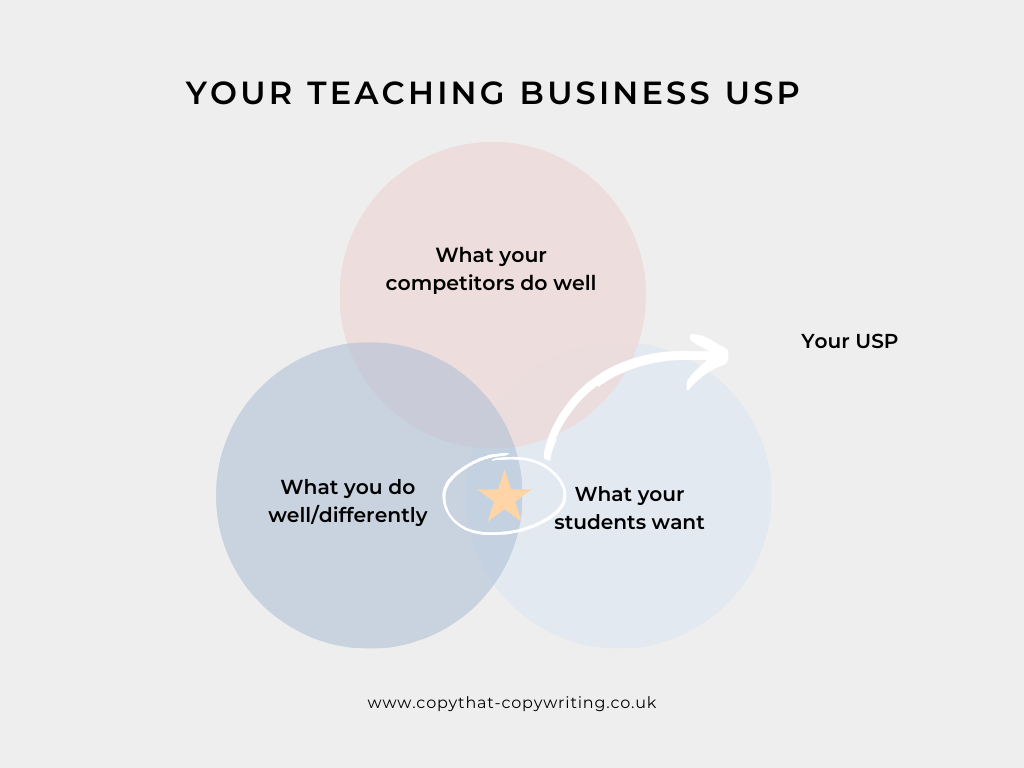What makes you unique as a language teacher?
Why should a student choose to learn with YOU over anyone else?
This is hands down one of the hardest questions to answer in business, especially for awkward introverts like me.
But it’s also one of the most important things to figure out if you want to stand out, attract your dream students and grow your teaching business.
Because when you’re competing against millions of other language teachers offering similar services, you need to make it crystal clear why people should choose you.
And if you don’t know what makes you special, how the heck will your ideal students?
If all that sounds totally overwhelming and scary, don’t worry. By the end of this article, you’ll know exactly how to find your unique selling point as a language teacher.
First things first: what is a unique selling point?
A unique selling point (USP from here on out) is the quality you have or service you offer that other teachers don’t.
It’s the *thing* you do better than any of your competitors — the core benefit of your service or your approach that makes it the ideal choice for your people.
I say ‘for your people’ because your USP should be specific to the students you want to work with.
It should connect your strengths with their problems and show how you’re best positioned to help them reach their goals.
Why do you need a USP as a language teacher?
It’s simple: a carefully crafted unique selling point is how you can clearly show that you’re the right person for the job.
Without it, it becomes much harder to stand out and even harder to persuade students to choose you. Especially when every teacher and their friends are using the same old promises, like ‘speaking clearly and confidently’.
Although you may be able to build a social media following and convert a few students with a generic promise like this, having a clear differentiator will make your marketing efforts easier and way more successful.
Getting clear on your values and beliefs
Your unique selling point should be rooted in a core belief that drives everything you do AND is something your people can get behind.
For example, it could be that rote memorisation doesn’t work, that body language is as important as spoken language, or that non-native speakers make the best teachers.
Whatever your beliefs and values underpinning your work, make sure to get clear on them before you write your USP statement.
What counts as a USP when you’re a language teacher?
As a language teacher, your USP could fall into one of three main categories: who you are and what you know, how you teach, or a unique feature you use to teach it.
Here are a few examples:
1. Who you are (and what you know)
This works best if you have a specific skill set or knowledge base that’s relevant to what you’re teaching your ideal students. For example:
- A former recruiter turned English teacher who helps people prepare for job interviews in the US.
- An engineer turned German teacher who helps engineers communicate more effectively at work.
2. How you teach
Do you do things differently to most other teachers? Have you developed a specific approach? Here are some examples:
- Using self-created storybooks to teach kids languages with characters they love.
- Using a brand-new method for simplifying Chinese characters and speeding up learning.
3. A unique feature
This works particularly well for businesses offering products, but it can also apply to courses — as long as you haven’t seen other teachers using it.
- Real-time pronunciation feedback with instant corrections and suggestions for improvement.
- Flexible live classes you can book any time to fit your schedule and your timezone.
See how each of these things stands out as different?
By focusing on the one thing that separates you from the other teachers in your niche, you make it easier for your ideal students to see where you sit in the market (hopefully above everyone else).
Note that this is just a starting point — your final USP statement should include more precise language so the reader not only sees, but believes why you’re the teacher they’re looking for.
How do you know which type of USP to choose?
The trick to crafting a great USP statement for your language teaching business isn’t to guess which one will resonate the most with your students, but to base your decision on cold, hard facts gathered from your market research.
So, before you pluck any old selling point out of thin air, ask yourself:
- What problem are your students facing?
- How have they tried to solve it before? Why didn’t this work?
- Why are you best positioned to help them?
Your USP statement should be the overlap between what you do super well and what your people really want.
This is the ONLY way to guarantee that it’ll stand out and speak to them.

Make sure to avoid that area above the USP star because that’s likely getting a little too close to what your competitors are known for.
Where should you use your USP statement?
This statement has two goals: to clearly show what makes you different from other teachers and to give direction to everything you write and post.
Let’s start with the first one.
You can use your USP (or a variation) as your website homepage heading and your social media bios. This allows new users to see exactly what you do and where you sit in the market from the moment they land on your page.
Behind the scenes, you can use your statement to guide the content you plan and the copy you write. It serves as a great reminder of what you do, why you do it and who you do it for, helping make sure your values and mission shine through in everything you do.
How to write a USP as a language teacher
Given that your unique selling point is unique, the way you write it should be, too.
I’ve included a template below to help you get started, but before we get to that, I figured it would be helpful to see how other companies phrase theirs. Just to show you that there is no one way to do it.
1. Duolingo
The big problem: Language learning is inaccessible and expensive
The USP: “Learn a language for free”
Category: A feature founded in the belief that language belongs to everyone.
2. Rosetta Stone
The big problem: No chance to get authentic language practice
The USP: “Take the translation out of language learning.”
Category: A system that encourages intuitive understanding and learning by doing, founded in the belief “that speaking the language well is the key to remembering and understanding.”
3. FluentU
The big problem: Authentic video materials are too difficult for language learners to understand.
The USP: “Learn a language with TV show clips, movie scenes, and music videos.”
Category: An approach that allows people to learn a language in a fun and immersive way.
Now it’s your turn to craft your teacher USP statement.
Here’s a template to help you get your ideas on paper and take the first step towards figuring out what makes you different:
I’m {this type of teacher} who helps {this group of people} {overcome this problem} and {achieve this goal} by/through {unique approach/method/feature}
And an example of this completed from one of my clients, Speak up with Stephanie:
I’m an ex-actor turned business English coach who helps badass professionals find their authentic voice in English through tried-and-true theatre techniques.
Once you’ve completed the template, use it as a starting point to craft your website headline or social media bios.
I’d love to read what you come up with! Comment below with your USP statement or send it to my email info@copythat-copywriting.co.uk.
January 22, 2024



did you enjoy this post? Share it!